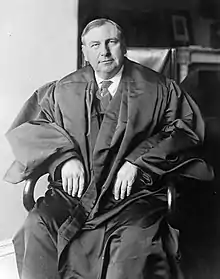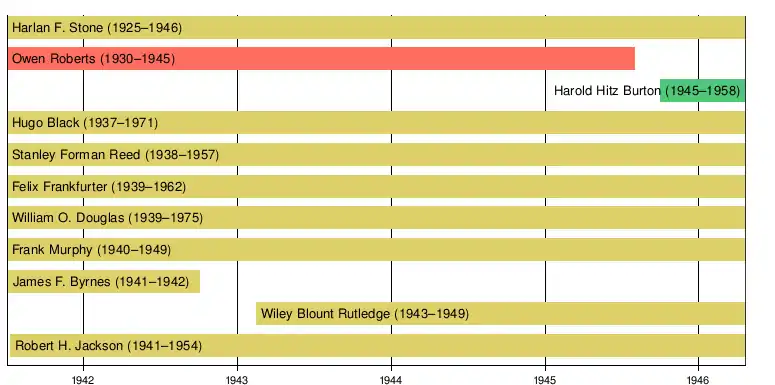Stone Court (judges)
The Stone Court refers to the Supreme Court of the United States from 1941 to 1946, when Harlan F. Stone served as Chief Justice of the United States. Stone succeeded Charles Evans Hughes as Chief Justice after the latter's retirement, and Stone served as Chief Justice until his death, at which point Fred Vinson was nominated and confirmed as Stone's replacement. He was the fourth chief justice to have previously served as an associate justice and the second to have done so without a break in tenure (after Edward Douglass White). Presiding over the country during World War II, the Stone Court delivered several important war-time rulings, such as in Ex parte Quirin, where it upheld the President's power to try Nazi saboteurs captured on American soil by military tribunals.[1][2] He also supported the federal government's policy of relocating Japanese Americans into internment camps.[3]
| Stone Court | |
|---|---|
 | |
| July 3, 1941 – April 22, 1946 (4 years, 293 days) | |
| Seat | Supreme Court Building Washington, D.C. |
| No. of positions | 9 |
| Stone Court decisions | |
 | |
Membership
The Stone Court began in 1941, when Associate Justice Stone was confirmed to replace Charles Evans Hughes as Chief Justice. Stone had served as an Associate Justice since 1925, when President Calvin Coolidge nominated him to the bench. During the Court's 1932–37 terms, Stone and justices Brandeis and Cardozo formed a liberal bloc called the Three Musketeers that generally voted to uphold the constitutionality of the New Deal.
At the beginning of Stone's chief-justiceship, the Court consisted of Stone, Owen Roberts, Hugo Black, Stanley F. Reed, Felix Frankfurter, William O. Douglas, Frank Murphy, James F. Byrnes, and Robert H. Jackson (the latter two joined the court days after Stone's elevation to Chief Justice). In October 1942, Byrnes resigned from the court to become the war-time Director of the Office of Economic Stabilization; Roosevelt appointed Wiley Blount Rutledge as his replacement. Owen Roberts retired in July 1945, and President Harry Truman appointed Harold Hitz Burton to replace him.
Shortly before V-E Day, Truman named Justice Jackson to serve as U.S. Chief of Counsel for the prosecution of high-ranking German officials accused of war crimes at the 1945–46 Nuremberg trials. As a result, Jackson was absent for one entire Court term, and his fellow justices had to do an extra amount of work during the term.[4] Stone died on April 22, 1946 after suffering a cerebral hemorrhage.[3] Truman subsequently appointed Fred Vinson as Stone's successor.
Timeline

Rulings of the Court
Major rulings of the Stone Court include:
- Glasser v. United States (1942): In a 7–2 decision written by Justice Murphy, the court reversed a criminal conviction on the basis that the defense attorney had a conflict of interest. The court also ruled that the exclusion of women from the jury pool violated the Sixth Amendment's Impartial Jury Clause. The court held that jury pools should be a "cross-section of the community."
- Betts v. Brady (1942): In a 6–3 decision written by Justice Roberts, the court ruled that indigent defendants did not have the right to an appointed counsel in state courts under the Due Process Clause. The case was overruled by Gideon v. Wainwright (1963).
- Wickard v. Filburn (1942): In a unanimous decision written by Justice Jackson, the court upheld wheat production quotas established by the Agricultural Adjustment Act of 1938. The appellant argued that the production quotas overstepped the powers granted to Congress by the Interstate Commerce Clause, as the appellant used the wheat to feed his own animals. However, the court ruled that the farmer would have bought more wheat had he not grown his own, thus affecting interstate commerce.
- West Virginia State Board of Education v. Barnette (1943): In a 6–3 decision written by Justice Jackson, the court held that the Free Speech Clause protected students from being forced to salute the American flag or recite the Pledge of Allegiance. The case overruled Minersville School District v. Gobitis, which had been decided just three years earlier by many of the same justices.
- Smith v. Allwright (1944): In an 8–1 decision written by Justice Reed, the court struck down a Texas law that allowed white primaries. The case overruled Grovey v. Townsend (1935), which had held white primaries to be constitutional on the basis that political parties are private organizations.
- Korematsu v. United States (1944): In a 6–3 decision written by Justice Black, the court upheld Executive Order 9066, which ordered the internment of tens of thousands of Japanese Americans living in the West Coast, many of whom were United States citizens. The court accepted the government's argument that the order was a matter of "military urgency". Legal scholars have denounced the ruling as one of the worst and most racist in American history, the other being Dred Scott v. Sandford and Plessy v. Ferguson.[5] In 2011, the Solicitor General's Office publicly disavowed the ruling.[5] The case was overruled by Trump v. Hawaii (2018).
- International Shoe Co. v. Washington (1945): In an 8–0 decision written by Justice Black, the court held that parties could be subject to the personal jurisdiction of a state court if said parties have "minimum contacts" with the state. The court rejected the appellant's argument that the company should not fall under the jurisdiction of the state of Washington since it did not maintain a permanent "situs" of business in the state, despite doing business in the state.
Judicial philosophy
Stone had largely sided with the government's position when the Hughes Court struck down several pieces of New Deal legislation, and the Stone Court (with the addition of several Roosevelt appointees) consistently upheld Congressional power pursuant to the Commerce Clause.[2] The Stone Court also upheld broad war-time powers for the government.[2] The Stone Court was less deferential in the area of civil liberties, striking down laws in cases such as Barnett, although Korematsu was a major exception to this trend.[2] Despite Roosevelt's appointment of seven of the nine justices (and the elevation of Stone), the justices held independent views and often found each other at odds in regard to civil liberties.[2][6] Stone himself received criticism for presiding over a divided and quarrelsome court.[7] Justice Frankfurter often took a position supporting judicial restraint in which the court took deference to the decisions of elected officials, while Justices Black and Douglas were more willing to strike down laws and precedents for what they saw as violations of constitutional rights.[6] Murphy and Rutledge joined Black and Douglas as part of the more liberal bloc, while Jackson, Reed, and Stone tended to side with Frankfurter.[8][9] Roberts often sided with the Frankfurter bloc, but was more conservative than the other eight justices.[9] Though outnumbered, the more liberal bloc led by Black and Douglas often took the majority in cases by peeling off the votes from the moderate bloc, and the two groupings of justices did not form as tight of blocs as had existed in the Hughes Court.[10] The short length of the Stone Court gave it little chance to establish a definitive legacy.[11] However, the Stone Court continued the Constitutional Revolution of 1937 that had started during the Hughes Court and foreshadowed the liberal rulings of the Warren Court.[12]
References
- Ex Parte Quirin, 317 U. S. 1 (1942)
- Renstrom, Peter (2001). The Stone Court: Justices, Rulings, and Legacy. ABC-CLIO. pp. 179–180. ISBN 9781576071533. Retrieved 2 March 2016.
- "Harlan Fiske Stone: Supreme Court Justice (1872–1946)". A&E Television Networks. April 2, 2014. Retrieved January 20, 2018.
- "Remarks of the Chief Justice, American Law Institute Annual Meeting, May 17, 2004". www.supremecourt.gov. Retrieved January 20, 2018.
- Savage, David G. (24 March 2011). "U.S. official cites misconduct in Japanese American internment cases". LA Times. Retrieved 2 March 2016.
- Urofsky, Melvin (1988). "CONFLICT AMONG THE BRETHREN". Duke Law Journal. 37 (1): 81–84. Retrieved 2 March 2016.
- Renstrom, 40-42
- Urofsky, 85, 87, 92
- Galloway, Jr., Russell (1 January 1983). "The Roosevelt Court: The Liberals Conquer (1937-1947) and Divide (1941-1946)". Santa Clara Law Review. 23 (2): 513–515. Retrieved 4 March 2016.
- Galloway, Jr., 516-520
- Finkelman, Paul (15 January 2014). The Supreme Court: Controversies, Cases, and Characters from John Jay to John Roberts [4 Volumes]. ABC-CLIO. pp. 819–821. ISBN 9781610693950. Retrieved 2 March 2016.
- Galloway, Jr., 527-531
Further reading
Works centering on the Stone Court
Works centering on Stone Court justices
- Fassett, John D. (1994). New Deal justice: the life of Stanley Reed of Kentucky. Vantage Press. ISBN 9780533107070.
- Feldman, Noah (2010). Scorpions: The Battles and Triumphs of FDR's Great Supreme Court Justices. Grand Central Publishing. ISBN 9780446580571.
- Ferren, John M. (2006). Salt of the Earth, Conscience of the Court: The Story of Justice Wiley Rutledge. University of North Carolina Press. ISBN 9780807876619.
- Howard, J. Woodford (2015) [1968]. Mr. Justice Murphy: A Political Biography. Princeton University Press. ISBN 9781400875641.
- Murphy, Bruce Allen (2003). Wild Bill: The Legend and Life of William O. Douglas. Random House. ISBN 9780394576282.
- Newman, Roger K. (1994). Hugo Black: A Biography. Pantheon. ISBN 978-0679431800.
- Urofsky, Melvin I. (1991). Felix Frankfurter: Judicial Restraint and Individual Liberties. Twayne. ISBN 9780805777741.
Other relevant works
- Abraham, Henry Julian (2008). Justices, Presidents, and Senators: A History of the U.S. Supreme Court Appointments from Washington to Bush II. Rowman & Littlefield. ISBN 9780742558953.
- Cushman, Clare (2001). The Supreme Court Justices: Illustrated Biographies, 1789–1995 (2nd ed.). (Supreme Court Historical Society, Congressional Quarterly Books). ISBN 1-56802-126-7.
- Friedman, Leon; Israel, Fred L., eds. (1995). The Justices of the United States Supreme Court: Their Lives and Major Opinions. Chelsea House Publishers. ISBN 0-7910-1377-4.
- Hall, Kermit L.; Ely, Jr., James W.; Grossman, Joel B., eds. (2005). The Oxford Companion to the Supreme Court of the United States (2nd ed.). Oxford University Press. ISBN 9780195176612.
- Hall, Kermit L.; Ely, Jr., James W., eds. (2009). The Oxford Guide to United States Supreme Court Decisions (2nd ed.). Oxford University Press. ISBN 978-0195379396.
- Hall, Timothy L. (2001). Supreme Court Justices: A Biographical Dictionary. Infobase Publishing. ISBN 9781438108179.
- Hoffer, Peter Charles; Hoffer, WilliamJames Hull; Hull, N. E. H. (2018). The Supreme Court: An Essential History (2nd ed.). University Press of Kansas. ISBN 978-0-7006-2681-6.
- Howard, John R. (1999). The Shifting Wind: The Supreme Court and Civil Rights from Reconstruction to Brown. SUNY Press. ISBN 9780791440896.
- Irons, Peter (2006). A People's History of the Supreme Court: The Men and Women Whose Cases and Decisions Have Shaped Our Constitution (Revised ed.). Penguin. ISBN 9781101503133.
- Kennedy, David M. (1999). Freedom from Fear: The American People in Depression and War, 1929-1945. Oxford University Press. ISBN 978-0195038347.
- Martin, Fenton S.; Goehlert, Robert U. (1990). The U.S. Supreme Court: A Bibliography. Congressional Quarterly Books. ISBN 0-87187-554-3.
- Schwarz, Bernard (1995). A History of the Supreme Court. Oxford University Press. ISBN 9780195093872.
- Tomlins, Christopher, ed. (2005). The United States Supreme Court: The Pursuit of Justice. Houghton Mifflin Harcourt. ISBN 978-0618329694.
- Urofsky, Melvin I. (1994). The Supreme Court Justices: A Biographical Dictionary. Garland Publishing. ISBN 0-8153-1176-1.